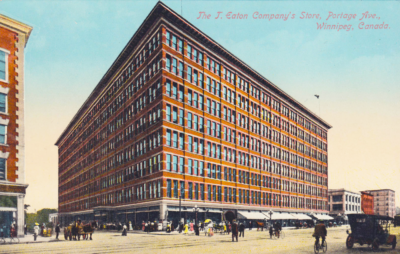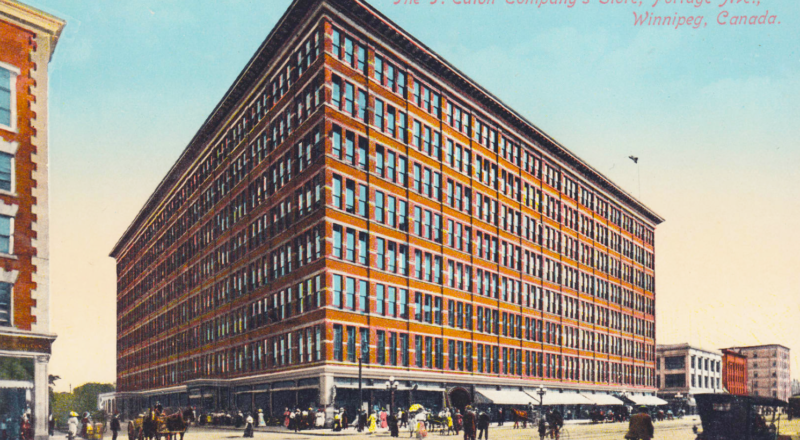
/ Blog
December 11, 2020
The Ancestor of Amazon: The T. Eaton Company Mail Order & Catalogue Building
Long before the invention of the internet, where you can simply point and click to purchase whatever your heart desires, there were mail order catalogues. Glossy coloured pages filled with countless wonderful things, all ready to be purchased from the comfort of your couch, Eaton’s catalogue was often referred to as the “Bible” in Western Canada. With Winnipeg’s prime location as a gateway to the the west, it became home to Eaton’s monumental mail order empire, the Amazon of the early 20th century. No item was too big or too small for Eaton’s to ship to your home, all from its vast building in downtown Winnipeg.
The T. Eaton Company Limited was established by Timothy Eaton in Toronto in 1869. Timothy Eaton was the Jeff Bezos of his time, worth approximately $5.25 million when he died in 1907, which would be over $100 million today! His retail store carried dry goods for a set price and only accepted cash, both practices being a radical departure from an economy based on barter and trade. With high quality goods at a low prices and a money back guarantee, Eaton’s was soon a retail force to be reckoned with! The company expanded in Toronto during the 1880s, with more retail space and a wider variety of products. For the middle class, the beautiful displays of affordable items proved irresistible. But Eaton’s real breakthrough came in 1884, with the publication of its first catalogue, “The Wishing Book,” 32 pink pages of marvelous things you could buy without ever setting foot in the store. The first of it kind in Canada, the catalogue was distributed to tourists during the Toronto Industrial Exhibition that year, with customers from across the country having access to Eaton’s desirable wares, with “samples sent to any address in the Dominion” (Eaton’s 1884 Fall/Winter Catalogue). The popularity was further facilitated by the spread of the railway, with Eaton’s eventually being able to offer free shipping on orders of $25, much like the modern day Amazon offering free shipping on orders over $35. The only difference being $25 in the late 19th century would be over $500 today – quite a sizeable order!
Winnipeg was Eaton’s first location outside of Toronto. A sophisticated young city with a bright future, Winnipeg was also a rail hub, providing a steady flow of goods to customers. John Craig Eaton, convinced his father, Timothy, to purchase an entire city block on Portage Avenue in Winnipeg to build their new store in support of the company’s expansion into western Canada. Land down Portage Avenue was more affordable than that found in the established central business district around the intersection of Portage Avenue and Main Street. Yet the land selected for Eaton’s still cost nearly $500,000. The purchase of land for a new post office on Portage Avenue between Fort and Garry Streets and for Eaton’s new store on Portage Avenue between Donald and Hargrave Streets in 1904 caused a monumental shift. Land values on Portage Avenue shot up while businesses rushed to relocate to the new central business district, which would eventually include the construction of Winnipeg’s iconic downtown Hudson’s Bay Store.

Eaton’s Portage Avenue store in Winnipeg.
Source: PartForward
Eaton’s new five storey department store in Winnipeg opened on July 17, 1905, with the massive red brick building quickly winning over the hearts of the 50,000+ people that visited before noon on the first day. The opening of the store also marked the introduction of a new version of the Eaton’s catalogue, specially for Western Canada. Already one of the largest employers in the city, expansion started only four years after opening in Winnipeg. Floors were added to the Portage Avenue store, a powerhouse, garages, a stable, a bus depot, a parkade and a printing plant and track warehouse would all become part of the Eaton’s empire in Winnipeg. Altough it was Eaton’s successful catalogue business that required the largest expansion. A permanent fixture in households across Western Canada in the first half of the 20th century, there was little that could not be ordered from Eaton’s catalogue. Like scrolling through Amazon on your computer or phone, the pages of the catalogue carried everything from food to clothes, to cars and barns. You could stock up on groceries, do your Christmas shopping or even order all the parts to build an entire town. Shipping might have taken a little longer than today, but we can all appreciate the timeless pleasure of packages arriving in the mail!
“This catalogue is destined to go wherever the maple leaf grow, throughout the vast Dominion. We have facilities for filling mail orders satisfactory, no matter how far the letter has to come and the goods have to go.”
-Timothy Eaton, 1887
As a family business, decisions could be made quickly to react to changing economic circumstances. While the Hudson’s Bay Company’s foreign management discontinued their catalogue in 1913, Eaton’s was on the ground in Canada and saw there was still a demand. To facilitate the ever growing popularity of Eaton’s catalogue business, in 1916 the company constructed a new building behind its Portage Avenue store in Winnipeg. It was essentially a giant production and fulfillment center with display space on the first floor so pedestrians on the street could admire the latest machinery and vehicles though the big plate glass windows. Known as the T. Eaton Company Mail Order & Catalogue Building at 333 St. Mary Avenue, it was designed in the Chicago School style by the Graham, Burnham & Company of Chicago, very much in keeping with the architecture of the store on Portage Avenue. Graham, Burham & Company were one of the top architectural firms of the time, having been previously hired by Eaton’s to work on their ambitious $10 million Toronto headquarter plans, which although designed, never came to fruition. The steel structure of the Mail Order Building allowed for wall to wall windows set in dark rust coloured brick on the upper stories and limestone on the lowest two, all supported by a stone foundation and capped with a grand cornice. Built in two phases, Mail Order Building Number One was eight storeys tall and covered nearly the entire north west quadrant of a city block. The construction cost $600,000 and would provide five acres of floor space for the company to expand into.
Interestingly, this building was a small part of what Eaton’s envisioned as a much larger building, one that would completely cover the two city blocks bound by Portage Avenue, Donald Street, St. Mary Avenue and Hargrave Street. A two storey tunnel would allow traffic to drive right through the middle of the building as they made their way down Graham Avenue. The southern block would be constructed and become the temporary store while the Portage Avenue building was replaced. The finished product would take around ten years to build, resulting in one overwhelmingly massive 12 storey building. New building bylaws, the end of Winnipeg’s economic boom, and a divided public opinion all stood in the way.
With some modifications, Eaton’s grand plan was actually approved by the city, with Mail Order Building Number One being the first phase. The second phase, Mail Order Building Number Two, was built in 1920 for $2.5 million. Designed by the same architect, the two buildings were identical in style although the second was 36.6 meters longer. Together they form what today is known as the T. Eaton Company Mail Order & Catalogue Building, becoming the same height after Building One had the ninth floor added in 1926. Being that the Eaton’s catalogue was 500 pages that year, it is not surprising they needed more space to fulfill all the orders! Making the task of filling orders even easier, personal shoppers could commute between the Mail Order Building and the Portage Avenue store through an underground tunnel. There was a Mail Order Building Number Three built in 1912 with a stable and garage, but it has since been demolished.
The Eaton’s catalogue was a trend setter, filled with the stuff that dreams are made of. It offered the latest fashion and the newest technology for everyone from the housewife to the farmer to the soldiers serving in WWII. It was a versatile publication, after being read cover to cover it was used for arts and crafts, wall decor, hockey pads, house instillation, learning English and personal hygiene in your outhouse. It helped popularize Canada’s favourite sport, hockey, selling both equipment and NHL sweaters starting in 1934. It was immortalized in Roch Carrier’s The Hockey Sweater, where a Montreal Canadians’ hockey sweater was ordered by way of a personal letter to “Monsieur Eaton”. Within two weeks the package arrived, but to the narrator’s great dismay, the package mistakenly contained a Maple Leaf’s sweater! Perhaps this was because the Toronto Maple Leaf’s players King Clancy, Lorne Chabot and Red Horner all endorsed hockey equipment sold in the Eaton’s catalogue?
“My mom was proud, she never wanted to buy our clothes at the general store. The only clothes that were good enough for us were the latest styles from Eaton’s catalogue.”
–The Hockey Sweater
Having only purchased one city block on Portage Avenue when real estate was cheap, expansion in Winnipeg proved particularly expensive for Eaton’s. As the city’s economy slowed Eaton’s slowed down its grand plan for expansion, bringing them to a halt as the Great Depression set in. As the city’s fortunes changed, so did the demographics of Eaton’s customers. Eaton’s mail order catalogue rose to popularity at a time when most Canadians did not live in cities, nowhere close to a department store. The catalogue opened up the world of the department store to those people who may not have the opportunity to set foot in such a facility. Although Eaton’s stopped selling its iconic houses by catalogue in 1931, Winnipeg’s Mail Order Building was still handling nearly 48,000 orders a day in 1934. The Eaton’s catalogue celebrated its 50th anniversary that year, declaring itself to be a “Canadian institution in the West, as in the East”. But by the 1970s most people lived within 30 minutes of an Eaton’s, and so it was far more convenient to visit the store to make a purchase than to order it through the mail. The 1976 spring catalogue was the last Eaton’s ever published, having amassed $20 million in debt before the mail order business was closed, and sadly seeing 9000 people loose their jobs.
The next year the Mail Order Building was sold for $10.8 million. More grand plans were made for the building but not much came of them. It was reopened as Eaton Place in 1979, part shopping centre, part office space, which attracted some large retail chains. Since then the Mail Order Building has changed hands several times, with various renovations and additions being made. The interior has seem the majority of the changes while the exterior facade is relatively unaltered, with the exception of alterations to the windows on the first two floors. Those involved with the building seem to be eternally optimistic about its future, but the best laid plans never seem to work out. Tenants in the office space have remained stable while the retail space has struggled. In 2009 the Manitoba Public Insurance (MPI), a major tenant since 1980, purchased the building for $80.5 million. MPI still owns it as of 2020 under the name of Cityplace, although there were rumors in 2019 that it might be put up for sale.
In 2020, the City of Winnipeg Historical Buildings and Resources Committee (HBRC) recommended that the Mail Order Building be added to the City of Winnipeg’s List of Historical Resources. The designation would only prevent alteration of the facade and demolition of the building, but this nomination has been met with resistance from the owners. MPI would prefer the building was added to the City of Winnipeg’s Commemorative List of Historical Resources, which does absolutely nothing to protect this historic building. Also as the building is property of a provincial Crown Corporation, it would not be bound by the rules of a municipal heritage designation. The city does recognize these limitations and has also formally asked the Province of Manitoba to designate the building. So why should the building be designated by the city if the province could tear it down regardless? Because the Mail Order Building may not always be provincially owned, and because the next owner may not be a champion of our community’s heritage. The HBRC’s recommendation went to the SPC on Property and Development, Heritage and Downtown Development on September 17, 2020, and the Executive Director of Heritage Winnipeg spoke in delegation supporting the designation. This committee concurred with the HBRC’s recommendation, as amended and it moved to the Executive Policy Committee on October 20, 2020, where is was then recommended to grant an extension to EPC of 90 days for a recommendation.
The Eaton’s Company was not one without its problems, few companies can rise to such monumental success without some less than desirable practices but it also employed thousands of Winnipeggers who worked reasonable hours and benefited from various social programming. With the loss of Eaton’s flagship store on Portage Avenue, the Mail Order Building is the last big Eaton’s building in downtown Winnipeg. It reminds us to dare to dream of bigger things, from gifts under the tree on Christmas morning, to brand new houses to business empires that connect a nation. Born from the pages of a simple catalogue, these dreams came to life and shaped our lives, forever leaving a mark on our hearts. May the City of Winnipeg see the wisdom in designating the T. Eaton Company Mail Order & Catalogue Building, forever protecting the ambitious aspirations of a city that dared to dream.
THANK YOU TO THE SPONSOR OF THIS BLOG POST:

Written by Heritage Winnipeg.
SOURCES:
Bank of Canada | Inflation Calculator
Biographical dictionary of Architects in Canada 1800-1950 | Graham, Burnham & Co.
Canadian History Ehx | Eaton’s and Canada
The Canadian Encyclopedia | Eaton's
Canadian Museum of Civilization | Eaton's
Canadian Museum of Civilization | The Story of the Mail-order Catalogue
City of Winnipeg Historical Buildings & Resources Committee | 333 St. Mary Avenue: T. Eaton Company Mail Order & Catalogue Building
City of Winnipeg Historical Buildings Committee | 450 Portage Avenue: Hudson's Bay Company Store
Cityplace | Celebrating 100 Years: 1919 – 2019
CTV News | This Winnipeg building may get a historical designation, but not all are on board
Library and Archives Canada | Canadian mail order catalogues - history
Winnipeg Free Press | Eaton's building historical resource designation debated
Winnipeg Free Press | MPI moves 100 staff out of CityPlace HQ
Winnipeg Places | 333 St. Mary Ave - Eaton's Mail Order Buildings / CityPlace (Pt. 1)
Winnipeg Places | 333 St. Mary Ave - Eaton Place Mall / cityplace (Pt. 2)
The Year Past 2017 | T. Eaton Company Mail Order & Catalogue Building











